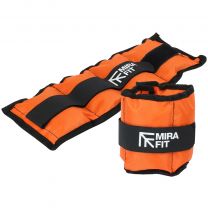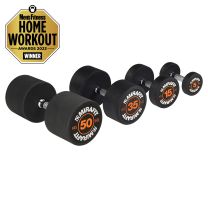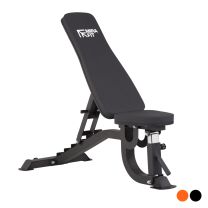Are Ankle Weights Too Retro?
Are Ankle Weights Too Retro?

A bright pink leotard, loud music, a gym step in front of you and some Ankle Weights strapped to your ankles. It sounds like a bad 80’s fitness video that is best forgotten.
The good news is that most of that has been left where it should have been….in the 80’s but should ankle weights be thrown out with the pink leotard?
The short answer is “NO!” There is still a place for ankle weights but to make sure you get the most out of your ankle weights we need to understand the advantages of the ankle weights and how to best use them.
The Benefits of Ankle Weights
Ankle weights have a couple of advantages over conventional weights. The most significant advantage is that they attach at your ankles. But the significance of this is that the weight is at the end of your “leaver” and this makes even light weights a significant contributor to the training load.
The second advantage is that ankle weights are not limited to the range of motion of standard weights. Any direction that you can move your legs in can now be weight bearing. By combining these first two advantages, you are able to load muscles in movements that seldom have resistance.
A third advantage is that the ankle weights are always attached to you. That is also a bit of an obvious statement but the point is that you can have the weights attached to you for the entire session. This not only makes it easy for you to quickly add in additional ankle weight exercises in between your normal exercises but it also can provide some additional resistance to your normal exercises.
But Ankle Weights are Only For Leg Raises...
We all know the classic ankle weight exercise of lying on your side and lifting your leg up and down. This image of ankle weight exercises can also be left in previous decades. Ankle weights can be far more versatile than that.
Let’s start with the muscle groups that are the primary targets for ankle weights. With the weights being attached to the ankles I would be worried if you didn’t mention that they target the legs but more specifically we can target the important muscle groups of the hip flexors, glute maximus and glute medius.
Hip Flexors
Movement: Lifts your thigh towards your torso as well as bending your torso towards your thigh.
Benefit: Important in stabilising the pelvic and spine to provide a strong core as well as lifting the thigh in movements such as running.
Glute Maximus
Movement: Extends the hip joint to move your torso into an upright position.
Benefit: Improve posture and strength athletic performance as the glutes drive most running and sprinting power
Glute Medius
Movement: Prevents pelvis from collapsing laterally during walking or running.
Benefit: Improves efficiency of walking and running movements and prevents injuries, particularly in the knee.
Not a bad start for the benefits of ankle weights but at the risk of sounding like an 80’s salesman, wait...thats not all!
Ankle weights can also add an additional load to stomach exercises. By doing abdominal exercise with ankle weights on you are increasing the load and making those abs work harder. Think of the additional benefit of doing 90 degree crunches while you have ankle weights on!
When Should You Avoid Ankle Weights
As with any form of exercise and equipment you need to know how to keep the exercise safe. The same applies to ankle weights and you should avoid using them for any of the following -
• Knee Injuries - if you have any knee pain you should avoid ankle weights. The added weight with the impact with the ground can aggravate this even further.
• High Impact Exercises - such as running and jumping.
• Excessive Use - Frequent use of ankle weights is a risk as would any exercise be. Rather limit the number of sessions to once a week. You can always add a second session in as you adapt to the training.
Do
• Include ankle weights into your sessions once a week to increase leg and core strength.
• Use in exercises with a range of motions that you can’t load during conventional exercises.
• Focus on Glute and hip flexor muscle groups.
• Include core exercises as part of your ankle weight routine.
Don't
• Use if you have knee injuries.
• Use with high impact exercises.
• Use heavy weights. Start light and build up. Remember the weights are at the end of your lever.
Great Ankle Weight Exercises
These are some of our favourite ankle weight exercises that can add fun and variety into your routine without the mundane leg raise style of exercise.
Ankle weight step-ups with knee raise

Perform a normal step up onto the Weight Bench but instead of stopping with both feet on top of the bench, lift your back leg towards your torso so the thigh is parallel to the floor.
This exercise will not only increase the load on the legs during the step up but will also load the hip flexor of the opposite leg.
Deadbug with Ankle Weights

With your ankle weights on, perform a deadbug exercise by lying on your back and engaging your core. Straighten the opposite arm and leg and then alternate to the other side. The ankle weights will increase the training load on the core and hip flexor muscles.
Single leg deadlift with knee raise

Perform a single leg deadlift with ankle weights attached, Instead of stopping at the top of the movement, keep moving the back leg up toward your torso and then start the next rep from this position. This exercise will add extra resistance to your glute maximus as well as loading the hip flexors. The added benefit of this exercise is that the glute medius is activated to help stabilise during the exercise.
Ankle weight squats with side leg raise

Perform a normal body weighted squat or add Dumbbells or barbells for extra resistance. Perform a normal squat and drive through the glute to return to the starting position. At the top of the squat position lift one leg out to the side and repeat on the opposite leg before starting the next rep. This will load the glute medius and other abductor leg muscles.
Written by guest author Brendan McBirnie.
For more content, follow us on Instagram, YouTube, TikTok, and on our official Mirafit Facebook page.
Enter your email to signup to our newsletter








